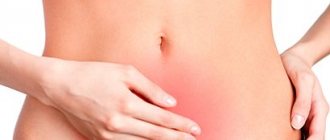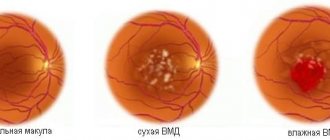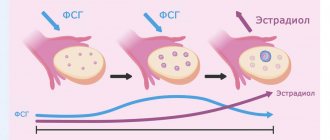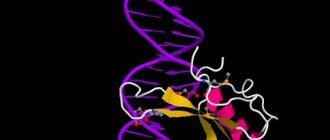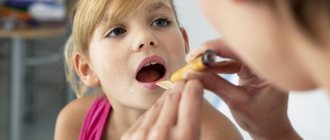Take the first step
make an appointment with a doctor!
One of the problems that an expectant mother may encounter is exhausted ovarian syndrome (OSS). This term refers to a complex complex pathology consisting in the premature cessation of the production of sex hormones and eggs, which makes conception and childbearing impossible. This disease is usually observed in women aged 35-40 years, but in some cases it can occur earlier. It is impossible to restore lost ovarian functions, so for patients it is, in fact, a death sentence in terms of realizing the desire to become a parent. What are the causes of this pathology, what contributes to its appearance and can it be avoided?
Causes of premature ovarian failure syndrome
To understand why this pathology develops, it is necessary to have an idea of how healthy ovaries work. This paired gland organ performs 3 functions in the body at once:
- Produces sex hormones (estrogens) that regulate reproductive and sexual function and are responsible for a woman’s age-related maturation;
- They produce eggs - sex cells, which, when fertilized by sperm (during sexual intercourse or during IVF), form an embryo, which subsequently develops into a full-fledged child.
The peak performance of the ovaries occurs from 15 to 35 years. The supply of eggs in them (ovarian reserve) is formed during the period of intrauterine development of a woman. Unlike men, she does not develop new germ cells - only those that are already present mature. With age, this supply gradually dries up - normally this process ends at 40-45 years of age (with some variations up or down), after which menopause (female menopause) occurs, characterized by the complete extinction of reproductive function. the inability to have children, serious hormonal changes in the body.
The depletion of the ovarian reserve itself is a normal process that every woman faces. It becomes a pathology if it occurs earlier than the biologically established norm - that is, before the age of 40. SIS is a rare disease and occurs in only 3% of women. At the same time, no changes are observed in the ovaries themselves, so the disease is not organic, but functional in nature. The exact mechanism by which the pathology appears has not been established for certain, but there are several working hypotheses:
- Genetic. Currently, most researchers are inclined to believe that hereditary predisposition is considered the decisive factor in the formation of SLI. It has been clinically established that ovarian hypotrophy is most often observed in women whose mothers or sisters also encountered a similar problem. In patients with established ovarian wasting syndrome, an extra X chromosome is more common.
- Autoimmune. Another possible cause of SIJ is the production of immune antibodies that inhibit the functioning of the glandular tissue of the ovaries. Such a reaction of the body to its own organs can occur independently or with various autoimmune disorders - hypothyroidism, vasculitis, systemic lupus erythematosus and other pathologies of a similar nature.
- Neurological. This hypothesis calls the main cause of early ovarian depletion organic damage to the parts of the central nervous system responsible for the functioning of the gonads (sex glands). In particular, dysfunction of the hypothalamic-pituitary system of the brain can lead to such consequences.
- Iatrogenic. In this case, the main factor causing early ovarian dysfunction is exposure to drugs or damage caused by external mechanical stress - for example, trauma, surgery (surgeries to remove cysts or other ovarian tumors). Actually, this hypothesis is not fundamental, since it explains only those cases of SSI in which disruption of the gonads is caused by obvious organic disorders.
Also, factors contributing to early ovarian failure syndrome include:
- Poisoning with toxic substances (including nicotine, alcohol, psychotropics) and medications, exposure to ionizing radiation (radiation);
- Anatomical abnormalities of ovarian development caused by genetic disorders or trauma;
- Infectious and inflammatory diseases of the pelvic organs, endocrine disorders, traumatic injuries to the ovaries.
- Psycho-emotional disorders, accompanied by frequent and sudden mood swings and nervous breakdowns.
In addition to premature decline of reproductive function, there are the following symptoms of ovarian wasting syndrome:
- amenorrhea - cessation of menstrual bleeding and, consequently, renewal of the uterine endometrium, necessary for normal conception and development of the child;
- cessation of ovulation - the production of healthy eggs involved in the conception of children;
- decreased libido (sexual desire), decreased natural moisture in the genital organs and, as a result, a feeling of dryness, discomfort and pain during sexual intercourse and movement (running, walking);
- sudden changes in mood, increased aggressiveness, tearfulness, frequent attacks of depression or apathy, indifference to oneself and others, panic attacks;
- decreased cognitive function, difficulty concentrating, memory, general decrease in performance;
- physiological symptoms - sudden bouts of sweating, increased body temperature and blood pressure, redness of the skin in the shoulders, chest and neck;
- increased bone fragility associated with endocrine and metabolic disorders accompanying SSI.
Thus, ovarian wasting syndrome negatively affects all aspects of a woman’s life, from the ability to have a child to the ability to perform professional tasks and everyday activities. Increased suspiciousness and a tendency to depression contribute to the development of an inferiority complex and social distancing in a patient suffering from SUS.
Take the first step
make an appointment with a doctor!
Recommendations
Before starting the treatment process, the patient must consult a specialist, which is explained by several points.
- Before starting any type of therapy, a complete examination of the patient is indicated. This is necessary to diagnose possible concomitant pathologies and to monitor the effectiveness of the measures taken in the future.
- As already mentioned, only functional cysts are subject to conservative treatment, the main reason for the appearance of which is disrupted hormonal levels.
- The duration of conservative therapy should not exceed three months. If there are positive dynamics, this period can be extended to six months.
In addition, there are conditions for which surgical intervention is indicated. These are ovarian cysts that appeared during menopause, a tumor, or a suspected malignant process. Delaying a visit to the doctor in such cases will only complicate the patient’s situation, while timely treatment with correctly selected methods is the key to a good prognosis for the patient’s life and health.
Diagnosis of ovarian wasting syndrome
Initially, the doctor examines the patient, collects information about the beginning and course of her menstrual cycles, the time at which the first signs of ovarian dysfunction were noticed. As a rule, women suffering from SIS do not have noticeable organic damage, their physique is normal, without pathological features. However, they look older than their years, they show signs of early aging of the body - gray hair, wrinkles, dull skin color, etc. In the primary diagnosis of SSI, cases of exposure to negative external factors (toxic substances, radiation, etc.) are of great importance. ), as well as the presence of reproductive problems among the patient’s relatives.
To identify this pathological condition, a woman undergoes a comprehensive medical examination, including the following tests:
- A gynecological examination reveals an abnormally low secretion of vaginal lubrication and the “pupil” effect (the presence of mucus from the cervical canal on the vaginal part of the cervix), and bimanual palpation reveals underdevelopment of the uterus relative to the age norm;
- Ultrasound of the ovaries and other pelvic organs allows us to determine genital infantilism, reduction in the size of the uterus, homogeneous structure of the myometrium, hypotrophy of the endometrium and gonads;
- Metrosalpingography - contrast X-ray examination of the uterine cavity and tubes with contrast reveals thinning of the endometrium, fibrous atrophy of the glandular tissue of the ovaries and the absence of follicles;
- Using diagnostic laparoscopy, the doctor determines the presence of changes in the gonads and takes samples of their tissue for histological examination;
- A blood test for hormones reveals an increased concentration of gonadotropins, a sharp decrease in female sex hormones (estrogens and progesterone);
- Densitometric testing is aimed at assessing bone density and the effectiveness of osteoporosis therapy;
- Electroencephalography detects functional disorders in the hypothalamic-pituitary system that are amenable to drug therapy.
- Computed tomography and magnetic resonance imaging are used to identify organic pathologies of the brain that can trigger ovarian wasting syndrome.
If other pathologies are detected in a woman (endocrine disorders, metabolic disorders, anomalies and injuries of the genital organs), the doctor may prescribe additional examinations and consultations with specialized specialists - a reproductive specialist, an endocrinologist, etc.
Take the first step
make an appointment with a doctor!
Determination of cystic formations
The ovaries play a huge role in the hormonal regulation of the female body.
From puberty until menopause, they produce estrogens, thanks to which female organs develop and function. Progesterone is the main hormone of pregnancy. The ovaries are susceptible to various diseases. The most common disorder associated with them is the development of cysts. A cyst is a formation of ovarian tissue that resembles a bubble surrounded by a capsule. Cysts, based on their origin, can be of several types:
- Congenital dermoid ovarian cyst. It consists of embryonic rudimentary elements that give rise to skin, nails, and hair. Due to genetic abnormalities, ectodermal tissue enters the ovary and can develop asymptomatically throughout life. When a significant volume is reached, pressure occurs on neighboring organs.
- Acquired functional. This disorder affects patients of childbearing age with various dyshormonal conditions. It is divided into follicular and corpus luteum cysts. Follicular ones develop from mature egg follicles that did not rupture at the right time. The pathogenesis of corpus luteum cysts is the accumulation of fluid or blood in the thickness of the ovary.
- Acquired endometrioid. It develops when cells of the functional layer of the uterus (endometrium) enter the ovary. Such cells undergo changes under the influence of hormones every month; they produce blood, which does not find an outlet and accumulates in the cavity limited by the capsule. Such forms usually give early symptoms.
- Serous cystadenoma, mucinous. They can be single- or multi-chamber.
Treatment of ovarian wasting syndrome
Since the causes of this pathology have not yet been precisely determined, its effective treatment does not exist. Full restoration of the function of the reproductive system (and, therefore, the ability to have a child) after the occurrence of SIJ is impossible, since it causes irreversible atrophy of the glandular tissue of the ovary. Modern treatment of SIS is aimed at eliminating the accompanying symptoms and includes the following types of therapy.
Medication. The main way to combat the symptoms of SUI is hormone replacement therapy, which replaces the work of the ovaries by supplying female sex hormones (estrogens and progesterones) from the outside. In particular, young women who are faced with this pathology are prescribed steroidal oral contraceptives (Zhanine, Novinet, Mercilon, etc.), the use of which allows them to simulate a normal menstrual cycle. It is also possible to use them in the form of injections, skin patches, vaginal suppositories, etc. In addition to synthetic hormones, the following are prescribed to combat the symptoms of ovarian depletion:
- multivitamin and mineral complexes, dietary supplements;
- sedatives - Tenoten, Afobazol, etc.;
- phytoestrogenic (plant analogues of estrogens) drugs - “Climafen”, “Qi-Clean” and others;
- antihypertensive (blood pressure-lowering) drugs - Tenorik, Bisoprolol, Enalapril.
- antidepressants (serotonin reuptake inhibitors) - Citalopram, Fluoxetine.
Drug therapy (hormonal and non-hormonal) does not restore ovarian function, but in practice it has shown its effectiveness in eliminating most symptoms of ovarian syndrome. The use of hormonal and non-hormonal drugs significantly improves the patient’s quality of life, provides her with full sexual activity and professional performance.
Physiotherapy. This is a group of techniques aimed at eliminating the physiological manifestations of SIJ and consisting of non-drug effects on the body. The most common types of physical therapy to treat the symptoms of ovarian failure syndrome are:
- Electrophoresis – exposure of tissue to weak electric currents that improve the transfer of medicinal and/or biologically active substances;
- Hydrotherapy (therapeutic shower or bath) – this method is based on the therapeutic effects of natural mineral waters;
- Massage, physical therapy and acupuncture - these types of physiotherapy are aimed at improving microcirculation in tissues, lowering blood pressure, improving muscle function, eliminating symptoms of physical weakness, psycho-emotional relaxation
Physiotherapy is considered as an adjunctive treatment for SIJ symptoms and is prescribed in conjunction with medication.
Therapeutic diet. Since many of the symptoms of ovarian wasting syndrome are associated with metabolic and endocrine disorders, properly selected nutrition demonstrates quite high effectiveness in eliminating them. In particular, the patient’s diet includes foods high in protein, calcium, iodine, vitamins, and saturated and unsaturated fatty acids. The most useful in this regard are sea fish and seafood (shellfish, algae, caviar, etc.), legumes, nuts, fresh vegetables and fruits. It is also recommended to avoid excessive consumption of coffee (it can cause a mild form of stimulant syndrome), fried and smoked foods, fast food and other harmful ingredients.
None of the methods listed above can treat ovarian pathology itself. However, they make it possible to maintain the remaining organs of the reproductive system in a normal functional state - the uterus, fallopian tubes, etc. This gives women with AIS the opportunity to become pregnant using IVF. Since her own body is no longer capable of producing viable eggs, donor genetic material will be used for conception in this case. The embryo obtained with its help is then implanted into the patient’s uterine cavity, and with properly prescribed maintenance hormonal therapy, she will be able to bear and give birth to a healthy child.
Take the first step
make an appointment with a doctor!
Which candles to choose?
Ichthyol suppositories in gynecology for ovarian cysts have an anti-inflammatory and antiseptic effect. The active substance is ichthyol. This substance is black in color and has a pungent odor. It is used rectally after natural bowel cleansing 1-2 times a day, it can also be used vaginally. The positive effect is achieved quickly enough due to good absorption of the substance. Ichthyol suppositories for ovarian cysts have good reviews due to the absence of contraindications and side effects.
Indomethacin for ovarian cysts reduces pain and swelling by blocking enzymes that cause inflammation. Refers to non-steroidal anti-inflammatory drugs. The effectiveness of the drug is achieved at 90%. Taken vaginally 1-2 suppositories per day, quickly absorbed. It is not recommended for patients with diseases of the gastrointestinal tract, liver, allergies, pregnant women and nursing mothers. Side effects include dizziness, drowsiness, abdominal pain, nausea and vomiting.
Diclovit is a non-steroidal anti-inflammatory drug. It is used as an anti-inflammatory drug for the pelvic organs. Administer rectally after defecation or a cleansing enema, 1-2 suppositories per day. It should not be prescribed for allergic reactions, bronchospasms, individual intolerance to the substance, or for pregnant and lactating women. Side effects: migraine, tinnitus, allergic reaction, and in rare cases, swelling of the legs. In case of overdose, confusion, nausea, vomiting, and bleeding may occur. The drug should be used very carefully in combination with other drugs.
In gynecology, longidaza is used for the treatment and prevention of adhesions formed due to the inflammatory process. It has immunomodulatory, antioxidant and slight anti-inflammatory effects. Has good absorption. One suppository is used after a two-day break. It is administered vaginally or rectally, after cleansing the intestines. Contraindicated for patients with cancer, pregnant women, children under 12 years of age, and kidney disease. Side effects manifest themselves in the form of an allergic reaction.
Suppositories with propolis are used as anti-inflammatory, antibacterial, antioxidant, and immunomodulatory agents. Used vaginally or rectally, after cleansing the intestines.
Treatment of SIJ with folk remedies
You can often find various recipes for treating ovarian dysfunction using improvised means - primarily medicinal plants. There really is a rational grain in this, since many herbs and natural products contain substances that improve the functionality of the reproductive system and relieve symptoms of SIJ. In particular, linden tea, decoctions of clover and hop cones, infusions of eggs with lemon, chamomile, yarrow, etc. demonstrate some effectiveness. However, when treating with folk remedies, the following points must be taken into account:
- unlike medicines, it is impossible to establish the exact dosage of active components in plants and other products without laboratory equipment, which is fraught with either insufficient effectiveness or an iatrogenic effect of such drugs;
- in addition to beneficial substances, plants and other products may contain toxic components that can further aggravate painful symptoms;
- the effectiveness of medicinal herbs is always less than that of medications, since the latter are specially designed to solve specific therapeutic problems.
Therefore, when treating ovarian depletion syndrome with improvised means, it is necessary to consult with your doctor. He will select the correct composition and dosage of medicinal herbs and check their compatibility with the body of a particular patient. In any case, such treatment cannot be the main one and is prescribed only as an addition to professional medical therapy.
Dandelion therapy
Dandelion is a frequently used herb in traditional medicine. All its parts (leaf, stem, root) have a healing effect. The cost of dried root in Moscow is 90 rubles per package. Quite a low price for such an effective drug. If you prefer to collect the product yourself, then the plant is harvested in March or November, and in the summer, medicinal procedures are carried out using the finished product. Dandelion has a special chemical structure that accelerates the regenerative properties of the body
It contains milky juice and leaves containing groups of vitamins, amino acids, resins, antioxidants and alcohols.
It is worth knowing that as a result of dandelion pollination, bees prepare medicinal honey, the use of which is required in the complex therapy of neoplasms.
Dandelion has a number of positive effects on the body:
- anti-inflammatory;
- tonic;
- antifungal;
- oncoprotective;
- sedative;
- choleretic;
- antiviral.
Decoctions and tinctures help remove excess fluid. The effectiveness of dandelion against tumor processes is determined by the removal of fluid from the body and cysts.
Prevention of early ovarian failure
SSI is caused by very specific medical reasons, so a woman may not encounter this problem at all if she follows simple recommendations:
- avoid exposure to toxic substances and ionizing radiation;
- do not self-medicate with medications;
- eliminate or minimize stressful situations at work or in your personal life;
- visit a gynecologist in a timely manner and undergo regular examinations of your reproductive system;
- monitor your diet, and also eliminate the use of alcohol, psychoactive substances, and smoking.
Another way to prevent and overcome this disease is egg cryopreservation. As a rule, SIA occurs after the age of 30, so a woman has a lot of time to preserve her genetic material in a cryobank while the ovarian follicular apparatus is still functioning. Freezing does not reduce the fertility of the germ cells, and they can be used for artificial insemination many years later.
How to use propolis
To prepare propolis ointment, you first need to hard-boil an egg, remove and grind the yolk. Heat 50 ml of vegetable oil in a thick-bottomed saucepan, add a piece of propolis the size of a matchbox. Wait until the propolis is completely melted, then add the yolk. Stir vigorously until a homogeneous mass is formed. It needs to be cooled and stored in a cool place. Before use, warm up the required amount of the drug, soak a tampon with it and insert it into the vagina. It is better to do the procedure in the evening and leave the tampon on overnight.
The use of alcohol tincture of propolis will be no less effective. You can prepare it yourself or purchase it ready-made, especially since its price in Moscow pharmacies is low.
To prepare your own tincture, first of all, you need to clean the propolis from foreign impurities. To do this, it is cut or broken into small pieces and filled with cold water. After 5–10 minutes, it needs to be drained along with any debris that has floated to the surface. The purified substance that has settled at the bottom is placed in a dark glass container and filled with alcohol. After two weeks, the product will be ready for use. It is taken 20-30 drops three times a day.
A mixture of 50 ml of propolis tincture, one glass of celandine juice and half a glass of honey gives a good result. It is taken a dessert spoon three times a day for a month.
Using soda
This is the most accessible folk remedy. Treatment of ovarian cysts in women is carried out as follows: you need to take 25 g of soda and quench it with ordinary table vinegar in the amount of 200 ml. Then the product must be thoroughly mixed with plain vodka (200 ml) and water (3 l) at room temperature.
After this, you need to fold a large piece of gauze or cotton fabric several times. Then you need to moisten it in the prepared solution and apply it to your stomach so that the skin above the pubic bone is also covered. The compress must be left overnight. In the morning, rinse off any remaining product with warm water.
The procedure must be done daily. The course of treatment is 20 days. Afterwards you need to take a break for 14 days and undergo an ultrasound examination. If there is no positive dynamics, the course must be repeated.
It is important to know that if you have cancer, it is unacceptable to use a folk remedy. In this case, only a doctor should treat ovarian cysts in women.
Using Shevchenko's mixture
According to numerous reviews, this is one of the most highly effective remedies for education. Most patients claim that after treating a cyst with a folk remedy at home, at the next ultrasound examination, specialists were surprised to note the absence of pathological cavities or that they were smaller in size.
The mixture is very easy to prepare. You need to take 25 ml of vodka (without any additives) and unrefined oil (preferably sunflower). Pour both ingredients into a small glass jar or bottle. Close tightly. Then the container with the contents must be vigorously shaken for 7 minutes. To prevent the mixture from splitting into fractions, it must be drunk immediately in one gulp.
Important information regarding how to cure an ovarian cyst with a folk remedy. You need to take Shevchenko's mixture three times a day 20 minutes before meals. It is advisable to consume it at regular intervals. But the minimum interval must be 6 hours. It is important to take the mixture exactly 20 minutes before a meal. If you start eating right away, its effectiveness will decrease several times.
The duration of treatment for ovarian cysts with a folk remedy is 10 days. Then it is important to take a break for 5 days. Afterwards the course can be repeated. Then take a break again for 5 days. Next time, the duration of the latter should be increased to 10 days. Then again after completing the course you need to take a break of 5 days. This regimen for taking Shevchenko’s mixture must be followed until the cystic formation disappears completely.
It is unacceptable to make adjustments to the schedule. It is also prohibited to increase or decrease the dosage of the drug. It is impossible to shorten the breaks, otherwise the body will begin to become addictive, which will significantly reduce the effectiveness of Shevchenko’s mixture.
Where can I buy
You can get folk remedies and ingredients for treating cysts on the pages of our online store “Russian Roots”. Couriers will deliver the ordered goods to Moscow and other localities in the capital region. In the case of other regions, delivery is carried out by mail. You can also select the necessary ingredients or folk remedies in our Moscow herbal pharmacies.
Attention! All materials published on our website are protected by copyright. When re-publishing, attribution and a link to the original source are required.
